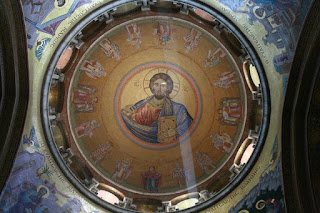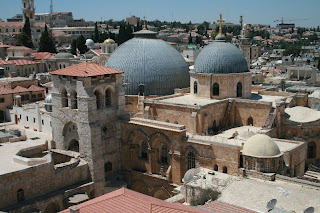The Dead Sea tour fell through for today, we will be going on Thursday instead, so we heading into the Old City for the last time, although the weather was so hot today it made doing anything an effort.

We began near our apartment by stumbling across Herod the Great's family tomb. Although nothing is made of it at the site, it is a fairly complete example of a high status tomb from the time and you can crawl around inside and explore.
Notice the huge stone that has been rolled away.
Outside the walls of the Old City is the City of David. This is the site of the city of Jebu, conquered by King David around 1000BC and occupied as Jerusalem until 586BC when the Babylonians destroyed it. It is now an archaeological site and museum with a 3D film about its history.
This tunnel allowed the Jebusites to fetch water from the Gihon Spring when under siege, but may also have been the route that David's soldiers crept through to capture the city. It was a long way down. It would have been a long way back up if we hadn't taken a bus.
Entering the Old City through the Dung Gate, the only gate we hadn't used, we explored the Jewish Quarter which centers on Hurva Square, a pleasant leafy square with plenty of cafes and a shop selling manna from heaven in the form of ice slush drinks.
The Jewish community have been trying to build the Hurva Synagogue for centuries, but one war or pogrom after another has seen it destroyed. This latest effort, due to be completed next year, is a multi-billion dollar project of the Israeli government.
The area beneath the new Jewish Quarter was once the priestly and upper class area of Second Temple Jerusalem. During the recent rebuilding, many of the remains of these houses have been excavated. One of the largest of these is the mansion preserved at the Wohl Archaeological Museum. The tables in this shot were the first pieces of furniture from this time ever discovered.
The Burnt House is just that - a house that was burned down in the Fall of Jerusalem in 70 AD. It is now a museum housing a dramatised multimedia reconstruction of the last days of the city and the Kathros family who lived there.
The presentation was in Hebrew but we had headphones tuned to the English version of events.
Next, an adventure! We went to St James Armenian Cathedral because we thought it was one of the very brief periods that it was open. However it was shut, being rarely used in the summer. When we asked at the gate about it we found ourselves being directed to follow a passing black robed priest and were led through the maze of the Armenian compound - a hidden city within the city. Eventually we came to the Church of the Archangel, where a service was taking place. We were allowed to be part of the service, being censed to the hilt and watching about 8 hooded, cloaked and robed priests performing ceremonies with much chanting, incense and candles. It was awesome.
After the service, a friendly Fr Gomidass Sherbetdjian, complete with hood and sunglasses, showed us round the church, including yet another prison of Christ and a tree he was allegedly tied to.
Following this we briefly returned to the Jewish Quarter to see the Cardo - once the Roman and Byzantine main street of the city. Today, the local children seem to love to play on the smooth flagstones beneath the ancient columns.
At the end of the afternoon we returned to our apartment via Mount Zion for a much needed rest.
This evening we went to the YMCA for dinner. The YMCA is not quite what you would expect it to be, being one of the best hotels in the city. No village people though.
Surprisingly we still ordered houmous even though there were other things on the menu - we must be getting a taste for it. (Laura still had chips though!)
























































